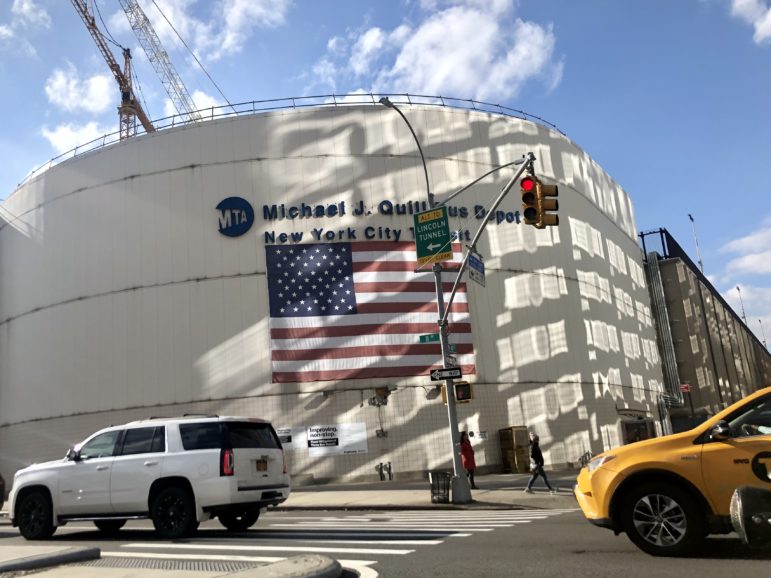
City Limits/Jeanmarie Evelly
The Quill bus depot on Manhattan’s west side, which flooded during Sandy.
Last month marked seven years since Hurricane Sandy hit New York City, and last Tuesday—the anniversary of the superstorm’s landfall—MTA officials took reporters on a tour of the Coney Island Railyard in Brooklyn, a storage site for more than 800 subway cars that was flooded by 27 million gallons of saltwater back in 2012.
Veronique Hakim, the MTA’s managing director, pointed out various parts of the yard that were upgraded since Sandy with storm protection features, including ongoing construction of a hulking flood wall around the site’s perimeter and as well as an elevated bridge to house power cables for the yard—which, pre-Sandy, would have been buried underground.
“Everything that we do going forward is engineering resiliency into the project,” Hakim told reporters of how the storm changed the agency’s building standards. “So everything that we’re building as part of the capital program, and in our next [2020-2024] capital program, includes elements of resiliency.”
Much has been said about how the MTA has rebuilt the subways since Sandy, repairing the extensive damage caused by the storm and fortifying it against future weather events: Over the last seven years, the agency has installed flood-protection features at 3,500 “points of water entry” throughout the subway system, completed or started repairs on eight of the city’s under-river tunnels, and rebuilt and reopened the damaged South Ferry station, among other high-profile projects.
But less attention has been paid to storm resiliency measures for the city’s bus network, which played a crucial role in the days immediately following Sandy, when flooding left the subways out of service for two full days, and in partial service for several days after that. By contrast, the bus system was “largely restored within 24 hours,” according to the MTA’s own resiliency report.
Buses: a disaster resource
“The buses have the advantage that they’re not tied to particular routes, so you always have more flexibility with buses—to send them along routes that are less flooded or not flooded at all, and still try to get close to the communities that need some transportation,” says Klaus Jacob, a special research scientist at Columbia University’s Lamont-Doherty Earth Observatory.
A 2014 report on how New York can prepare and adapt for climate change, which Jacob helped author for the state’s Energy Research and Development Authority, found that bus commuters account for 11.8 percent of the city’s population living in the floodplain.
“After Sandy, the bus network was really important,” says Mitchell Moss, who heads NYU’s Rudin Center for Transportation Policy & Management. To keep New Yorkers moving after the storm, the MTA employed the use of “bus bridges,” sending hundreds of buses over bridges into Manhattan, which included turning the Manhattan Bridge into an exclusive “busway” and creating bus-priority lanes on major Manhattan corridors like Lexington Avenue and 23rd Street, according to a Rudin Center report. On the Friday following the storm, buses shuttled 3,700 riders per hour into Manhattan, the same report notes. Bus service continued to be integral in the Rockaways post-Sandy, where A train service on the peninsula remained suspended for months after the storm, and free shuttle buses and extra bus service helped plug the gap.
The MTA’s existing preparedness plans for extreme weather include mapping out similar “emergency bus bridge” routes that could operate under a variety of situations, as well as setting up possible bus-route detours in neighborhoods prone to flooding, such as the Rockaways and Staten Island. For hurricanes and coastal storms, the MTA’s policy is to curtail bus service six hours before “the predicted onset of sustained gale force winds,” then preparing the network by relocating buses and other vehicles to higher ground and topping off fuel tanks, according to information provided by a spokesman. Bus depots are prepared to operate on emergency generators should power go out, the MTA says.
Sandy’s toll
Of course, the subways suffered more extensive damage from Superstorm Sandy than the rest of the transit system. However, the storm took its toll on the bus system, too. While the MTA prepared its buses for the storm by moving vehicles to higher ground, six bus depots in low-lying areas flooded, including the Far Rockaway, 126th Street and the Michael J. Quill depot on Manhattan’s west side, according to an MTA report. Depots located in flood zones pose a risk to the efficiency of the bus system, even if the buses themselves are spared from damage: If depots are rendered inaccessible by flooding, it can make it harder to refuel and maintain buses, leading to a “a reduction in fleet capacity,” over time, according to Jacob.
“If they lose their connection to their logistical support, meaning fuel and sometimes maintenance, over time, that still cuts into capacity,” he says.
Since Sandy, the MTA has completed or announced plans to start resiliency work at six of its bus depots, according to a spokesman. This includes the Far Rockaway depot, which was “significantly flooded” during the superstorm and underwent an $11.5 million overhaul that wrapped up in 2018, which included repairing storm damage and flood-proofing the facility. Another $7 million in resiliency work was completed at both Manhattan’s Quill depot and the Yukon depot on Staten Island, according to the MTA.
More projects are in the pipeline: $20.7 million has been budgeted for more extensive flood mitigation upgrades at Quill, as well as at Staten Island’s Castleton depot and the Casey Stengel bus depot in Flushing. The three sites will get updates like flood panels for garage doors and reinforced structural walls, while the depots’ windows, mechanical and utility equipment will be relocated above the flood elevation—work that’s slated for completion in October 2020.
Concerns about vulnerabilities
But there’s more that could be done, says Mark Henry, president of the Amalgamated Transit Union Local 1056, which represents MTA bus drivers and has been calling for expedited flood protection measures at the Casey Stengel depot since the months immediately following Sandy. Henry called the MTA’s preparedness response “slow” and “scatter-gunned.”
“As far as the Transit Authority is concerned, they seem to always put buses on the back burner until things go wrong,” Henry says. “Buses [are] always the afterthought, and they probably should be in the forethought.”
He sites the dilapidated bus depot in Jamaica, Queens, as another example of an overlooked facility. Though not located in a flood zone, the facility is crucial to bus operations in much of Queens, he and others say, and it long ago outgrew its needed capacity. Though the MTA purchased land to expand the depot five years ago, construction on the project has yet to start.
“Jamaica bus depot is the oldest and most antiquated bus depot in the city, and it’s probably been in five capital plans that extend five years each, and it has not been built yet,” says City Councilman Daneek Miller, a former MTA bus driver and ATU Local 1056 leader who now represents several neighborhoods in southeastern Queens. Construction on the expanded Jamaica Depot is now expected to start next year and finish in 2025, according to an announcement from the MTA in September.
Making buses a priority
But ensuring the resiliency of the bus system can go beyond MTA facilities, experts say. In its report 2012 analyzing the transit system’s Sandy performance, NYU’s Rudin Center recommended the MTA and city permanently institute priority bus lanes on its bridges and major roadways, as it did in the wake of the storm.
“If buses continued to have priority on bridges and throughout the major arteries of Manhattan and the outer boroughs, large numbers of people could move through the city more efficiently,” the report reads.
That recommendation hasn’t come to full fruition, though some improvements have been made: Today, the Verrazano, Manhattan and Queensboro Bridges have HOV-lane requirements, but there are no dedicated bus lanes on the city’s bridges.
When it comes to streets, the city’s Department of Transportation currently operates 16 Select Bus Service routes, which use dedicated bus lanes, and earlier this month —after a number of delays—launched a bus-only corridor along Manhattan’s 14th Street.
Last week week also saw the passage of City Council Speaker Corey Johnson’s “Master Street” plan, which will require the DOT to install 150 miles of “physically or camera-protected bus lanes” in five years. Meanwhile, the MTA is in the process of redesigning bus routes in each borough for more efficient service, something Councilmember Miller says is “great to see” and a sign that the agency is finally starting to pay more attention to buses.
“The subway has so many limitations,” he says. “The bus network has been undervalued and not been addressed for decades.”










